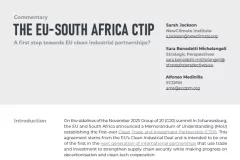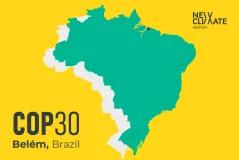Our NewClimate Institute experts will be on the ground in Baku, participating in multiple events, releasing new publications during COP29. You can find an overview of upcoming events and publications, as well as our take on key topics to watch below:
Reach out to our experts on the ground: Prof. Dr. Niklas Höhne (all topics, 13-20 Nov), Dr. Takeshi Kuramochi (Mitigation by national and subnational governments and companies,13-18 Nov), Maria Jose de Villafranca Casas (Mitigation by national governments, 12-15 Nov), Victoria Fischdick (Media, 12-15 Nov)
What to expect at COP29 climate summit in Baku
The UN’s biggest annual climate talks are set to take place in Baku, Azerbaijan, from November 11-22, 2024. With planet-heating greenhouse gas emissions at record highs and ongoing reports of disastrous impacts of climate change – from extreme hurricanes in the US to deadly flooding in Africa – COP29 take places at a critical time.
COP29 is the second of three consecutive COP climate summits from 2023-2025, known as the “Troika,” which includes the United Arab Emirates (COP28), Azerbaijan (COP29) and Brazil (COP30). Building on the progress at COP28, which marked the conclusion of the first-ever Global Stocktake, COP29 is expected to focus on mobilising climate finance, paving the way for COP30 to turn the new round of national climate targets into concrete action.
The focus of this year’s climate summit will be setting a new finance goal post-2025 – the New Collective Quantified Goal (NCQG). Developed countries are tasked with defining this target to support climate action in developing countries, replacing the current $100 billion annual goal. However, progress has been slow amid disagreements over who should pay and how.
Beyond delivering a new climate finance goal, COP29 will likely see announcements of new national climate commitments – known as Nationally Determined Contributions (NDCs) – for 2035. Negotiations on Article 6 will continue to iron out rules for international carbon markets. Expanding funding for the Loss and Damage Fund, which countries agreed to operationalise at COP28, is also on the agenda. Given that the COP29 is hosted by a petrostate, there will also be considerable scrutiny in how much progress can be made in advancing the landmark agreement from COP28 to transition away from fossil fuels.
Ahead of the agenda-packed COP29, NewClimate experts round up key topics to watch in this blog post, along with their insights on what should – or should not – happen to keep the 1.5°C goal alive.
New cycle of NDCs
With new NDCs expected by February next year, there is growing anticipation for countries to present updated targets for 2035 during COP29. These NDCs, required to be submitted every five years, are crucial for aligning national climate action with the Paris Agreement’s goal of limiting global warming to 1.5°C. So far, no country has submitted the NDCs for 2035 as of early November.
The ‘Troika’ of COP Presidencies has called for “early submissions of high ambition NDCs,” pledging to announce their “1.5°C-aligned NDCs” by the end of this year. This call comes as Azerbaijan faces criticism for weakening its own NDC in 2023, earning a “critically insufficient” rating in its climate action from our Climate Action Tracker analysis. The country is expected to release its new NDC shortly.
If countries fully implement unconditional NDCs, the world is on track for a temperature rise of 2.9°C above pre-industrial level by the end of the century, according to the UN Emissions Gap Report, well beyond the 1.5°C limit needed to avoid the worst impacts of climate change. In the most optimistic scenario, where conditional NDCs and net-zero pledges are also considered, the chance of limiting global warming to 1.5°C is only 14 percent.
Current NDCs for 2030 remain woefully insufficient. However, there is still a window for action to keep the 1.5°C goal alive, according to Maria Jose de Villafranca, a NewClimate expert who works on the Climate Action Tracker, NewClimate’s flagship project with Climate Analytics.
"In this critical moment, it is important that all governments commit to ambitious climate targets for 2035 and strengthen their 2030 targets, incorporating the outcomes of the Global Stocktake: doubling energy efficiency, tripling renewables, and phasing out fossil fuels to put the world on a net-zero emissions pathway for 2050," said de Villafranca.
"These ambitious climate targets need substantive climate finance. Developed countries, who bear higher historical responsibility, need to step up their contributions to support those who need help achieving the transition," she added.
Guided by the findings of the Global Stocktake, which indicated that the world is far off track in meeting the goals of Paris Agreement, countries agreed to transition away from fossil fuels, triple renewable energy capacity and double energy efficiency improvements by 2030, while also aligning financial flows with the goals of Paris Agreement, among other measures, at COP28.
While every country must step up, some countries – such as India, China and the European Union – are particularly well-positioned to lead the way as they are already on track to meet their current NDC targets, according to a report that annually evaluates the progress of major emitters towards their climate targets.
“Better planning and more doing. Although countries need to come up with more ambitious targets in their new NDCs, following that up with credible policies is fundamental to translate the Paris Agreement ambition into action” said NewClimate expert Dr. Leonardo Nascimento, the lead author of the report and a contributor to the Emissions Gap report.
COP29 host country’s initiatives
In recent UN climate summits, COP presidencies have introduced a series of climate initiatives – such as pledges, declarations and partnerships – to drive cooperative climate action. Although these initiatives are not binding and occur outside of formal negotiations, they aim to complement official UNFCCC efforts.
However, making high-level pledges is one thing; acting on them is another. Effective implementation of these initiatives requires detailed plans and robust monitoring mechanisms, which are often missing. This gap raises questions about the effectiveness of such initiatives in achieving the goals of the Paris Agreement. A study analysing initiatives launched around COP26 in Glasgow found their impact on emissions to be limited, largely due to insufficient endorsements from key emitters in respective sectors, a lack of follow-up actions by signatory governments, and inadequate monitoring mechanisms and institutional capacity.
Some initiatives have been more instrumental in generating momentum for climate commitments in critical sectors. For example, the Global Methane Pledge – the first major initiative to tackle methane emissions – was launched at COP26, with 158 countries participating to collectively reduce emissions by 30% from 2020 levels by 2030. Progress is tracked by international organizations such as the International Energy Agency and supported by the Climate and Clean Air Coalition's secretariat services. Similarly, the Global Renewables and Energy Efficiency Pledge at COP28 in Dubai, which aims to triple renewable energy capacity and double energy efficiency improvements by 2030, garnered 133 signatories and has a monitoring system to track follow-up actions. This goal was also featured in the COP28 final text.
As COP29 approaches, Azerbaijan also announced 14 climate initiatives, covering action areas from energy storage to methane emissions reduction from the waste sector. Among the notable is the Climate Finance Action Fund (CFAF), which seeks contributions from fossil fuel-producing countries and companies. As a founding contributor, Azerbaijan aims to raise $1 billion for the fund, with half allocated to climate projects in developing countries and the other half to help member countries meet their national climate targets.
This initiative marks the first time fossil fuel-producing countries are explicitly called upon to contribute more to the shift away from fossil fuels, though concerns about its effectiveness and transparency remain. The CFAF will only become operational once $1 billion is raised and at least 10 countries join as shareholders. Attention will be on which fossil fuel-exporting nations participate, particularly major oil exporters like Norway, which has positioned itself as a leader in climate action and yet still relying on oil revenues.
To ensure these pledges translate into meaningful action toward global climate goals, NewClimate expert Dr. Takeshi Kuramochi stresses the importance of domestic follow-up actions for implementation.
“COP initiatives have helped governments and non-state actors to explore higher ambition in specific sectors and thematic areas. However, this exploration needs to be accompanied by more formal commitments and robust implementation, including NDCs and domestic legislation,” he noted. “If not, these initiatives will end up becoming mere talking shops, as we have seen in the past."
Negotiations over Article 6
After limited progress made at COP28, the COP29 presidency has highlighted the finalisation of negotiations on Article 6 as a “second major expected deliverable,” while the US and EU have signalled a strong desire to reach an agreement. Article 6 of the Paris Agreement lays out UN rules for countries to cooperate towards the implementation of their Nationally Determined Contributions (NDCs) through carbon markets (Articles 6.2 and 6.4). This means that, under Article 6, countries can sell carbon credits generated from activities within their territories to help other countries meet their climate targets.
At COP29, negotiations are expected to centre on refining the rules and frameworks to fully operationalise Article 6 mechanisms. Currently, the compliance carbon markets are operating without clear rules and robust safeguards. Under Article 6.2, countries are allowed to trade Internationally Transferred Mitigation Outcomes (ITMOs) – the carbon credits under Article 6.2 – through bilateral or multilateral agreements, allowing them to count them towards their NDCs. This decentralised mechanism offers limited oversight, giving countries flexibility in choosing the types of activities that generate credits. Known as the Paris Agreement Crediting Mechanism, Article 6.4 proposes a more centralised mechanism for trading emission reductions among countries, companies, or even individuals under the supervision of UNFCCC, but it still lacks clear operational frameworks.
The negotiations on Article 6 have proven highly contentious, highlighting a fundamental disagreement among countries on how strict or loose the rules for international carbon markets should be. Proponents of Article 6 argue that international carbon trading can drive higher ambitions for mitigation efforts by allowing countries to cooperate in reducing emissions and investing in lower-cost mitigation opportunities abroad. However, critics warn that this approach may diminish the incentives for domestic climate actions, potentially jeopardising the goals of the Paris Agreement.
Article 6 has the potential to become a significant loophole in climate action if strict safeguards are not established, warns NewClimate expert Juliette de Grandpré. Currently, there are no requirements to ensure that credit-generating activities are truly additional or to prevent countries from selling emissions reductions they may need now or in the future to meet their own targets. Without such safeguards, countries selling their emissions reductions may struggle to meet their own NDCs, potentially resorting to more costly, less accessible mitigation options. For countries or organisations whose targets are not aligned with a 1.5°C pathway, the option to purchase carbon credits to meet their targets could potentially replace or delay their own emissions reductions efforts, which we cannot afford in light of the pressing climate crisis.
“The risk is high that Article 6 will fail to meet its objective of raising ambition and instead lead to less ambitious NDCs, exacerbating the climate crisis due to the lack of safeguards on the integrity of supply and demand for carbon credits,” de Grandpré said.
As countries gather at COP29, climate finance must take precedence over “carbon finance.” Carbon finance stems from transactions involving ITMOs, which not only involves the transfer of funds but also mitigation outcomes. Climate finance, in contrast, does not involve the transfer of mitigation outcomes, thus avoiding these issues.
“Discussions at COP29 should prioritise establishing stringent rules and safeguards to ensure that Article 6 mechanisms genuinely enhance mitigation efforts. This includes setting clear criteria for which activities can generate ITMOs and which cannot,” she added.
Written by Hyunju (Laeticia) Ock, Writer & Editor at NewCliamte Institute








